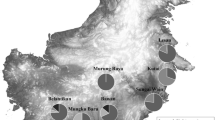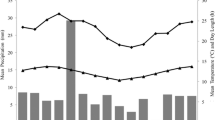Abstract
Field data on the whooping display in the Nilgiri langur were recorded in two ways: (1) the number of whoops heard while in the forest during a complete day; (2) the number of whoops heard by each of three troops while under constant observation from dawn to dusk for a total of 18 days. The temporal, visual, and auditory qualities of the display are described. Different methods of graphically representing the daily pattern of the whooping display are then exhibited. One method shows a main bimodal trend in whooping with a main peak in early morning and a smaller peak in the afternoon which is in accordance with other primate species. Secondarily, other ways of representing the data show that the morning peak is actually a series of peaks which decrease in magnitude after the initial peak. Additionally, the total amount of whooping is reduced during clear days and the initial morning peak is affected by the seasonal change in sunrise. The methods of representing data show that the gross trend of whooping is in reality a series of fluctuations which probably have relevance to the general activity as measured by the percent of individuals in the troop observed feeding. As in whooping the feeding activity when observed continuously in one troop for one day is a series of four to seven peaks rather than a bimodal distribution as represented by data of many days lumped together. A similar phenomenon of cycling in ontogenetic data is discussed.
Similar content being viewed by others
References
Altmann, S. A., 1959. Field observations on a howling monkey society.J. Mamm., 40: 317–330.
Altmann, S. &J. Altmann, 1970.Baboon Ecology. Univ. Chicago Press, Chicago, pp. 220.
Beck, B. B. &R. Tuttle, 1972. The behavior of gray langurs at a Ceylonese waterhole. In:The Functional and Evolutionary Biology of Primates,R. Tuttle (ed.), Aldine-Atherton, Chicago, pp. 351–377.
Carpenter, C. R., 1964. A field study in Siam of the behavior and social relations of the gibbon (Hylobates lar). In:Naturalistic Behavior of Nonhuman Primates,C. R. Carpenter (ed.), Penn. State Univ. Press, University Park, pp. 144–271.
————, 1965. The howlers of Barro Colorado Island. In:Primate Behavior,I. DeVore (ed.), Holt, Rinehart, & Winston, New York, pp. 250–291.
Chivers, D. J., 1969. On the daily behaviour and spacing of howling monkey groups.Folia primat., 10: 48–102.
————, 1972. The siamang and the gibbon in the Malay peninsula. In:Gibbon and Siamang,D. M. Rumbaugh (ed.), S. Karger, Basel, Vol. 1, pp. 103–135.
————, 1973. An introduction to the socio-ecology of Malayan forest primates. In:Comparative Ecology and Behaviour of Primates,R. P. Michael &J. H. Crook (eds.), Academic Press, N. Y., pp. 101–146.
Golani, I., 1973. Non-metric analysis of behavioral interaction sequences in captive jackels (Canis aureus L.).Behaviour, 44: 89–112.
Horwich, R. H., 1972. Home range and food habits of the Nilgiri langur,Presbytis johnii.J. Bom. Nat. Hist. Soc., 69: 255–267.
————, 1974. Regressive periods in primate behavioral development with reference to other mammals.Primates, 15: 141–149.
van Lawick-Goodall, J., 1968. The behaviour of free-living chimpanzees in the Gombe Stream Reserve.Anim. Behav. Monogr., 1(3): 1–311.
MacKinnon, J., 1974. The behaviour and ecology of wild orang-utans (Pongo pygmaeus).Anim. Behav., 22: 3–74.
Nelson, K., 1973. Does the holistic study of behavior have a future? In:Perspectives in Ethology,P. P. G. Bateson &P. H. Klopfer (eds.), Plenum Press, N.Y., pp. 281–328.
Poirier, F. E., 1967. The ecology and social behavior of the Nilgiri langur (Presbytis johnii) of South India. Unpubl. Ph. D. Thesis, Univ. of Oregon, 322 pp.
————, 1970a. The Nilgiri langur (Presbytis johnii) of South India. In:Primate Behavior,L. A. Rosenblum (ed.), 1: 251–383.
————, 1970b. The communication matrix of thr Nilgiri langur (Presbytis johnii) of South India.Folia primat., 13: 92–136.
Ripley, S., 1965 The ecology and social behavior of the Ceylon gray langur,Presbytis entellus thersites. Ph. D. Thesis, Univ. of California, pp. 422.
————, 1970. The social organization of foraging in gray langurs,Presbytis entellus thersites. In:Old World Monkeys,J. R. Napier &P. H. Napier (eds.), Academic Press, N.Y., pp. 481–509.
Rosenblum, L., 1971. Infant attachment in monkeys. In:The Origin of Human Social Relations,H. R. Schaffer (ed.), Academic Press, N.Y., pp. 85–113.
Sabater-Pi, J., 1970. Aportacion a la ecología de losColobus polykomos satanas, Waterhouse 1838, de Rio Muni.P. Inst. Biol. Apl., 48: 17–32.
Schaller, G. B., 1963.The Mountain Gorilla. Univ. Chicago Press, Chicago, pp. 431.
Tanaka, J., 1965. Social structure of Nilgiri langurs.Primates, 6: 107–122.
Thirkettle, G. L., 1968.Wheldon's Business Statistics and Statistical Method. English Language Book Society, London, pp. 308.
Yoshiba, K., 1967. An ecological study of Hanuman langurs,Presbytis entellus.Primates, 8: 127–154.
Author information
Authors and Affiliations
About this article
Cite this article
Horwich, R.H. The whooping display in nilgiri langurs: An example of daily fluctuations superimposed on a general trend. Primates 17, 419–431 (1976). https://doi.org/10.1007/BF02382905
Received:
Accepted:
Issue Date:
DOI: https://doi.org/10.1007/BF02382905




